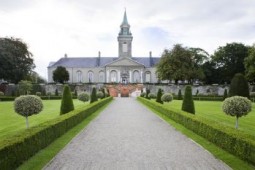The History of the Royal Hospital Kilmainham
The Royal Hospital Kilmainham was based on a design of the 17th century Les Invalides building in Paris. James Butler of Kilkenny Castle founded the Hospital. James Butler was the Duke of Ormonde and Viceroy to King Charles the Second. The foundation stone was laid in 1680 and it was completed four years later. William Robinson, the Official State Surveyor General was the architect responsible for creating the Royal Hospital. James Butler wanted the Royal Hospital to be a home for his pensioner soldiers. It continued to be a home for the elderly soldiers until 1927. The Commander in Chief of the army resided there among the soldiers. The original military hospital was established by Strongbow in the Phoenix Park. It was run by the Knights of St. John of Jerusalem, but was destroyed in 1670. Not long after the Royal Hospital’s establishment, Dr Steeven’s Hospital was built close to it in 1720 and this was a smaller and similar architectural style
The building was used as a military headquarters during the Rising, where two mounted machine guns were placed on the main building’s roof to fire down on rebel positions at Roe’s Distillery and at the Rialto entrance to South Dublin Union. Unfortunately, pinning down rebels at Mount Shannon and separating them from the rest of Ceannt’s men.The Royal Hospital was given to the Free State in 1922, along with most other public assets. The Garda Headquarters used it for twenty years between 1930 and 1950.
The North Wing of the building contained the Master’s Quarters, the Great Hall, the Chapel and the Vaulted Cellar with the 19th century kitchen. The pensioners resided in the South, East and West Wing of the building. The grounds of the Royal Hospital are beautifully kept. The Garden is an early 18th century design augmented with statues representing the Greek gods of the arts and science. It is named the “Sunken Gardens”. The Bully’s Acre Cemetery contains a 10th century stone believed to be a former high cross, the grave below contains the remains of Brian Boru’s grandson and possibly, the former high king himself. Other oddities in the graveyard, include surviving cherubs from a statue of Queen Victoria, the statue itself was moved to Perth Austraila, while its sister statue of Albert resides on Leinster House’s grounds.
Veterans from the Bore War are interred in the hospital burial grounds, though the main mass of bodies are most likely cholera epidemic victims. Where the Kilmainham Garda Barracks are now located was the former 19th century stable buildings.
The Office of Public Works (OPW) remodelled the building between 1980 and 1984. The OPW received a Europa Nostra Award in 1986. The OPW built a restaurant in the basement of the North Wing in 1987. The OPW also restored the Master’s Quarters in the North Wing. The OPW established a venue for modern art in 1988. The Gordon Lambert collection was placed in the West Wing on the ground floor. The OPW is continuing to restore the Royal Hospital Kilmainham gardens to their original 17th century style. They changed the courtyard to cobbled stone with a paved surface. This is where the public enter the gallery. One of the victims of this redevelopment of the hospital were the trees along its main avenue, which are now being replaced. Up the mid 90s, the Royal Hospital was still being used as a grazing ground for cattle.
The West Gateway was rebuilt in Kilmainham in 1840 after it became a traffic obstruction when it was a gateway at Watling Street on the Quays. The Royal Hospital Kilmainham became the Irish Museum of Modern Art in May of 1991 at the behest of former controversial Taoiseach Charles Haughey, who was trying to promote Ireland as a culturally rich country. The Irish Museum of Modern Art consists of artwork from the 20th century from both Irish and International artists. IMMA also facilitates community and educational programmes. The Royal Hospital of Kilmainham also holds concerts and different events throughout the year.
Upcoming concerts being held over the summer.
Beck June 17th 2015
Counting Crows June 24th 2015
Kodaline June 26th 2015
Manu Chau June 26th 2015










Nice work. It’s worth mentioning that Sea Sick Steve is on the Counting Crows bill and is likely to be an antidote to the insipidness of the former.
Thank you for the article. The statue of Queen Victoria that was kept in the graveyard actually resides in Sydney, situated on the corner of Druitt and George Street, not Perth as this article states.
My Grandad Patrick Maurice Mc Garry was a Gardner in the hospital in 1911. He and his family lived in what was known as the “ dispensary “ according to the 1911 census. He died in 1918, while his family continued to live in Kilmainham until the 1940s. Can anyone advise me where in the hospital or grounds was the dispensary and if anyone has come across any records mentioning his name.
Kind Regards. Phillip Mc Garry